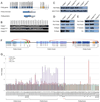Functional significance of isoform diversification in the protocadherin gamma gene cluster
- PMID: 22884324
- PMCID: PMC3426296
- DOI: 10.1016/j.neuron.2012.06.039
Functional significance of isoform diversification in the protocadherin gamma gene cluster
Erratum in
- Neuron. 2012 Sep 6;75(5):928-9
Abstract
The mammalian Protocadherin (Pcdh) alpha, beta, and gamma gene clusters encode a large family of cadherin-like transmembrane proteins that are differentially expressed in individual neurons. The 22 isoforms of the Pcdhg gene cluster are diversified into A-, B-, and C-types, and the C-type isoforms differ from all other clustered Pcdhs in sequence and expression. Here, we show that mice lacking the three C-type isoforms are phenotypically indistinguishable from the Pcdhg null mutants, displaying virtually identical cellular and synaptic alterations resulting from neuronal apoptosis. By contrast, mice lacking three A-type isoforms exhibit no detectable phenotypes. Remarkably, however, genetically blocking apoptosis rescues the neonatal lethality of the C-type isoform knockouts, but not that of the Pcdhg null mutants. We conclude that the role of the Pcdhg gene cluster in neuronal survival is primarily, if not specifically, mediated by its C-type isoforms, whereas a separate role essential for postnatal development, likely in neuronal wiring, requires isoform diversity.
Copyright © 2012 Elsevier Inc. All rights reserved.
Figures




References
-
- Buss RR, Sun W, Oppenheim RW. Adaptive roles of programmed cell death during nervous system development. Annu Rev Neurosci. 2006;29:1–35. - PubMed
-
- Chen HH, Hippenmeyer S, Arber S, Frank E. Development of the monosynaptic stretch reflex circuit. Curr Opin Neurobiol. 2003;13:96–102. - PubMed
-
- Esumi S, Kakazu N, Taguchi Y, Hirayama T, Sasaki A, Hirabayashi T, Koide T, Kitsukawa T, Hamada S, Yagi T. Monoallelic yet combinatorial expression of variable exons of the protocadherin-alpha gene cluster in single neurons. Nat Genet. 2005;37:171–176. - PubMed
-
- Feng G, Tintrup H, Kirsch J, Nichol MC, Kuhse J, Betz H, Sanes JR. Dual requirement for gephyrin in glycine receptor clustering and molybdoenzyme activity. Science. 1998;282:1321–1324. - PubMed
Publication types
MeSH terms
Substances
Grants and funding
LinkOut - more resources
Full Text Sources
Molecular Biology Databases

